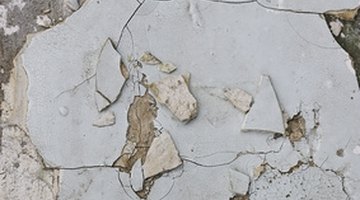Problems With Skim Coating Plaster Walls
Skim coating is the process of applying thinned joint compound to a wall and then smoothing it out. Plaster walls were once the norm, but after World War II, homebuilders began to use drywall panels for ease of installation. Installed over small strips, called lath, plaster walls are durable. But after a few decades, they can crack if your home settles. Skim coating to return the wall to its former smoothness might be possible, but be aware of potential problems that can affect the results.
Loose Plaster

When a plaster wall cracks, loose bits of plaster often fill the cracks. If you do not remove it, dry bits of plaster can come out of the cracks during the skimming process, making the skimming compound lumpy and marring the smooth finish.
Trowel Control
Skimming walls requires practice to able to use the same trowel technique over the entire wall. For uniform results, you must apply the same amount of pressure at the end of the skimming job that you did on the first skimming pass.
Premature Drying
Thinned joint compound dries to a hard powdery finish, but if it dries before you skim it smooth, you could end up with lumps and ridges. Porous plaster walls can increase premature drying by absorbing moisture in the skimming compound before you can smooth it out.
Too Much Compound
Joint compound shrinks slightly as it dries, making it imperative to apply multiple thin coats of the compound over the plaster walls instead of one thick coat. A thick application dries slowly and is apt to warp, leaving your wall uneven.
Air Bubbles
Bubbles can form in the skimming compound during the mixing process if you use a drill with a paddle attachment to blend the compound. During skimming, the bubbles can rise to the surface of the wet compound, requiring additional skimming with a trowel to smooth them out.
Time Constraints
Because skim coating requires multiple applications, your room will be out of commission for at least a few days. Each coat of skimming compound must dry completely before you can sand it and apply the next thin coat.
References
Writer Bio
Glenda Taylor is a contractor and a full-time writer specializing in construction writing. She also enjoys writing business and finance, food and drink and pet-related articles. Her education includes marketing and a bachelor's degree in journalism from the University of Kansas.
Photo Credits
- old wall image by AGphotographer from Fotolia.com
More Articles



